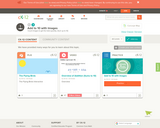
This course features a video review of addition up to the sum of ten for first graders.
- Subject:
- Elementary Mathematics
- Mathematics
- Material Type:
- Lecture
- Provider:
- CK-12 Foundation
- Provider Set:
- CK-12 Elementary Math
- Date Added:
- 06/25/2018

This course features a video review of addition up to the sum of ten for first graders.

This activity is designed to determine the appropriate instructional level for a student in a one-on-one interaction with the teacher.

This activity is designed to determine the appropriate instructional level for a student in a one-on-one interaction with the teacher.

In this assessment in a one-to-one setting, a student is shown the numbers from 1Đ10, one number at a time, in random order. The teacher asks, Ňwhat number is this?"

This assessment task can be used with a single student or a small group of students. Each student needs his or her own set of numeral cards.

This assessment may be used in a small group or whole group setting, give each student a piece of paper. Students who have trouble writing certain numbers can then get targeted practice.

This three-act math task utilizes videos and questioning to help students explore number combinations.

This task suggests methods of introducing and continuing choral counting in the classroom.

This course is designed to take the concepts you learn in developmental math to expand your knowledge of algebra. This course will focus on two major algebraic concepts to learn - how to SOLVE equations and how to GRAPH equations. Throughout this course you will be challenged to recall ALL of your prior knowledge of operations of real numbers as well as your knowledge related to solving and graphing linear equations (which you should have already mastered from developmental algebra). You will use this prior knowledge to expand on learning the following objectives: solving linear & rational equations. operations of complex numbers, solving quadratic equations, solving radical & polynomial equations, solving equations with rational exponents, solving linear and compound inequalities, solving absolute value equations and inequalities, graphing linear equations & slope, understanding concepts of domain, range and function notation, finding compositions of functions, finding inverses of functions, solving and graphing exponential and logarithmic equations, solving and graphing systems of equations and inequalities, and graphing conics.
*Open Campus courses are non-credit tutorials and cannot, in and of themselves, be used to satisfy degree requirements at Bossier Parish Community College (BPCC). (College Algebra Course by Bossier Parish Community College is licensed under a Creative Commons Attribution-NonCommercial-NoDerivatives 4.0 International License. Based on a work at http://bpcc.edu/opencampus/index.html.)

The purpose of this task is to help students understand the connection between counting and cardinality. Thus, oral counting and recording the number in digit form are the most important aspects of this activity. However, teachers can extend this by making a bar graph about how many students are wearing the color each day.

When educators and learners are not in the same room, strategies for communication are essential for continuing the learning process and collaborating with colleagues. In this video you’ll learn how to stay connected, collaborate and coach your students remotely with tools like Pages, Numbers, Keynote, FaceTime, and Messages.

This task suggests ways to incorporate counting circles into classroom activities.

This activity allows students to practice counting.

This task gives students another way to practice counting and gain fluency with connecting a written number with the act of counting. This task should be introduced by the teacher and would then be a good independent center.

The most engaging way to practice counting with students is to have them count meaningful things in their lives. Since five-year-olds are very focused on themselves this is easily done by allowing them to count themselves, their friends and objects within the classroom that relate to their daily lives.

The objective of this lesson is to gain automaticity counting to 100 and to establish the importance of multiples of ten. The final goal of this lesson is for students to be able to count by tens and articulate the term for this.

This task supports students in correctly writing numbers. Because students have to trace the number, instead of coloring in a bubble with the number in it or circling the correct number, they gain handwriting practice as well as counting and addition practice.

This card game allows students to practice number skills.

This game will reinforce number before and after as well as reading and sequencing numbers.

This task aims to give students practice counting and recording the given number on quantities up to 20.